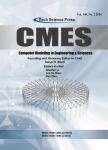Fractional Analysis of Dynamical Novel COVID-19 by Semi-Analytical Technique
作者机构:School of Systems and TechnologyUniversity of Management and TechnologyLahore54770Pakistan Department of MathematicsCankaya UniversityAnkara06530Turkey Institute of Space SciencesMagureleBucharest077125Romania Department of MathematicsGovt.College TownshipPunjab Higher Education DepartmentLahore54770Pakistan Department of MathematicsIslamia University of BahawalpurBahawalpur63100Pakistan Department of MathematicsUniversity of Management and TechnologyLahore54770Pakistan Institute for Groundwater StudiesUniversity of the Free StateBloemfontein9300South Africa
出 版 物:《Computer Modeling in Engineering & Sciences》 (工程与科学中的计算机建模(英文))
年 卷 期:2021年第129卷第11期
页 面:705-727页
核心收录:
学科分类:07[理学] 0701[理学-数学] 070101[理学-基础数学]
基 金:The authors are thankful to their respective departments and Universities
主 题:Novel COVID-19 semi-analytical scheme fractional analysis
摘 要:This study employs a semi-analytical approach,called Optimal Homotopy Asymptotic Method(OHAM),to analyze a coronavirus(COVID-19)transmission model of fractional *** proposed method employs Caputo’s fractional derivatives and Reimann-Liouville fractional integral sense to solve the underlying *** the best of our knowledge,this work presents the first application of an optimal homotopy asymptotic scheme for better estimation of the future dynamics of the COVID-19 *** proposed fractional-order scheme for the parameterized model is based on the available number of infected cases from January 21 to January 28,2020,in Wuhan City of *** the considered real-time data,the basic reproduction number is R0≈2.48293 that is quite *** proposed fractional-order scheme for solving the COVID-19 fractional-order model possesses some salient features like producing closed-form semi-analytical solutions,fast convergence and non-dependence on the discretization of the *** graphical presentations have demonstrated the dynamical behaviors of subpopulations involved in the underlying fractional COVID-19 *** successful application of the scheme presented in this work reveals new horizons of its application to several other fractional-order epidemiological models.



